Shantyboat Urge
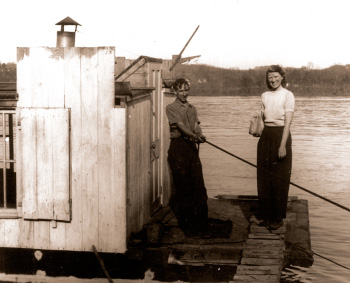 In the late 1970s I read Harlan Hubbard's Shantyboat. As a child, thirty years earlier, I'd been fascinated by
little floating homes in Florida.
In the late 1970s I read Harlan Hubbard's Shantyboat. As a child, thirty years earlier, I'd been fascinated by
little floating homes in Florida.
Anna and Harlan married in 1943. She was 41, a librarian; he was an artist, two years older. "We went to the riverbank, built a shantyboat, and began a new life together... (in) more perfect harmony with the river... close to the earth." Hubbard's writing is clear and unpretentious; the book has dozens of his drawings and woodcuts.
Their shantyboat was 24 feet by 10 feet. Compared to most with equal decks, the larger stern deck had "more advantages than we could foresee." Anna would pull sweeps from there when Harlan towed, rowing the 14 foot "johnboat," his third he'd built since his 20s - this one shapely enough for him.
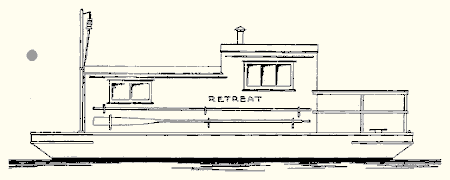 One morning a female white and black-spotted terrier, still almost a puppy, "crawled" from under the partly built
shantyboat hull. "Skipper" stayed. On a rising Ohio River in December of 1946 they drifted away from Brent, Ohio.
Bees' hives were on the aft deck, and Skipper had come back in the afternoon.
One morning a female white and black-spotted terrier, still almost a puppy, "crawled" from under the partly built
shantyboat hull. "Skipper" stayed. On a rising Ohio River in December of 1946 they drifted away from Brent, Ohio.
Bees' hives were on the aft deck, and Skipper had come back in the afternoon.
The summer of 1947 they were tied to the river bank in Payne Hollow, Kentucky. Catching and smoking catfish, foraging, gardening, and canning continued. Near Owensboro, Kentucky, a solidly frozen Ohio River broke with rising water, forcing them and a neighbor's logging machinery to drag their boat above it. That winter Skipper had her fifth litter, including a black pup.
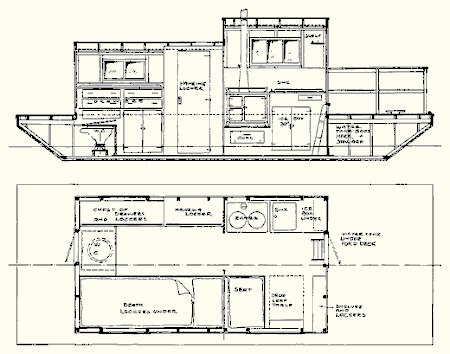 Six or seven miles up the Cumberland River as it rose in the spring of 1948, they came to Bissell Bluff, Kentucky.
They moored, and rented a cabin for "storage & studio... for 50 cents a week." Their lives went on,
of gleaning and scavenging, growing food and grinding their flour, waving at crews of familiar tugs and occasional
steamboats.
Six or seven miles up the Cumberland River as it rose in the spring of 1948, they came to Bissell Bluff, Kentucky.
They moored, and rented a cabin for "storage & studio... for 50 cents a week." Their lives went on,
of gleaning and scavenging, growing food and grinding their flour, waving at crews of familiar tugs and occasional
steamboats.
Trepidation about the Mississippi grew with dire warnings from river people. Although the Hubbards' experience gave confidence, the power of the River staggered them. He sounded to me like a person seeing the Grand Canyon for the first time. Their third winter of drifting brought them to Natchez for ten months, still harvesting and canning pokeweed and "dewberries," (blackberries). In May 1950 they made New Orleans.
To push and pull them west into Louisiana's bayous, they bought a flat bottom "skiff," about 13 feet, with a worn out, single cylinder inboard. Anna's French fluency was appreciated by Cajuns, as was the Hubbards' kindness reciprocated by gardener-farmers and river people along the 1385 miles.
In the spring of 1951, they sold their shantyboat, its motor skiff, and the johnboat. He rebuilt a single axle
trailer, adding a 10 foot by 4 foot by 16 inch box. They bought a 10 year old Dodge. In June, they left
for Payne Hollow, Skipper between them; the big, black, long-haired son of her fifth litter (of nine) in the backseat.
What urge captured them? They were not dilettantes about 'back to the land,' nor music or boating. From their first days together they played duets, Anna on cello; Harlan on either his viola or violin. Harlan wrote of line handling, "... a never failing pleasure, one of the joys to me of river life."
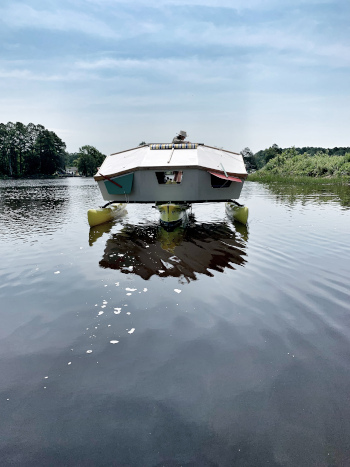 Michael Scheibeck's favorite shantyboat, from his library days of boating, is "Retreat." Motor Boating magazine
printed William Atkin's shantyboat during WWII. She's 18 feet LOA by 7 feet with an 11 foot deck house. Michael emailed,
"She really got her hooks into me." After decades of sailing, he includes himself among boaters thinking, "Time
on the water is just never enough... a shantyboat seems like having one's cake and eating it, too."
Michael Scheibeck's favorite shantyboat, from his library days of boating, is "Retreat." Motor Boating magazine
printed William Atkin's shantyboat during WWII. She's 18 feet LOA by 7 feet with an 11 foot deck house. Michael emailed,
"She really got her hooks into me." After decades of sailing, he includes himself among boaters thinking, "Time
on the water is just never enough... a shantyboat seems like having one's cake and eating it, too."
A smaller shantyboat yet is Jim Brown's Box Turtle. He built Box onto his WindRider 17 - his trimaran design from 2002. He prefers living on sailboats he can sail, but he has severe macular degeneration. His first thought about Box came after a near collision with a speeding power boat. He was sailing fast, wind and wave ruckus hiding the power boat's noise. He didn't see the big boat that blasted by close off his bow, so he decided it was too perilous to sail alone. But he knew, too, like so many of us, he wanted to be on a boat.
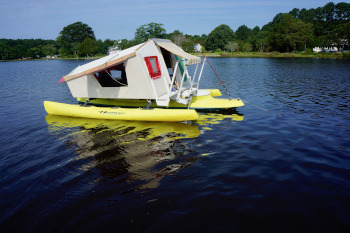 Box Turtle's floor space is 10 feet by 8 feet. Jim is 6 feet 3 inches, so, he can only stoop in the cabin,
as he's done in countless boats in his 88 years. He emailed "The essence of a shantyboat for me is an ace in the
hole - in case of a global, societal collapse." I know, though, he wants to eat and sleep, floating on the water.
Box Turtle's floor space is 10 feet by 8 feet. Jim is 6 feet 3 inches, so, he can only stoop in the cabin,
as he's done in countless boats in his 88 years. He emailed "The essence of a shantyboat for me is an ace in the
hole - in case of a global, societal collapse." I know, though, he wants to eat and sleep, floating on the water.
Here in Cedar Key, that urge has born the tent we're making for 10 foot 4 inch Clam Girl.
~HH